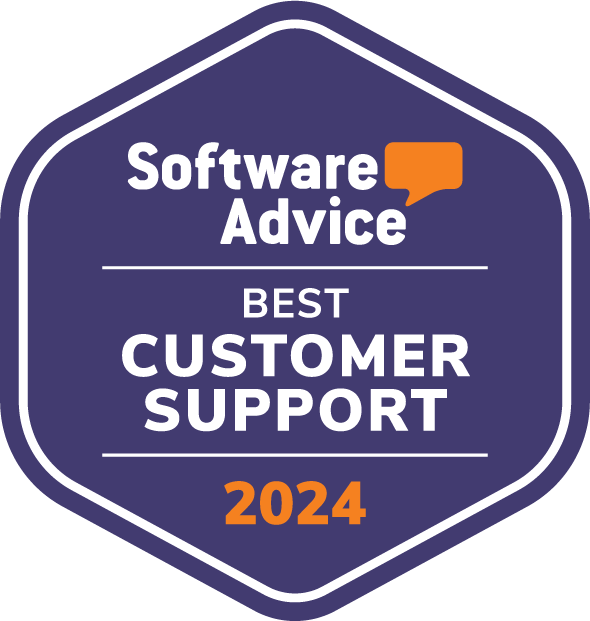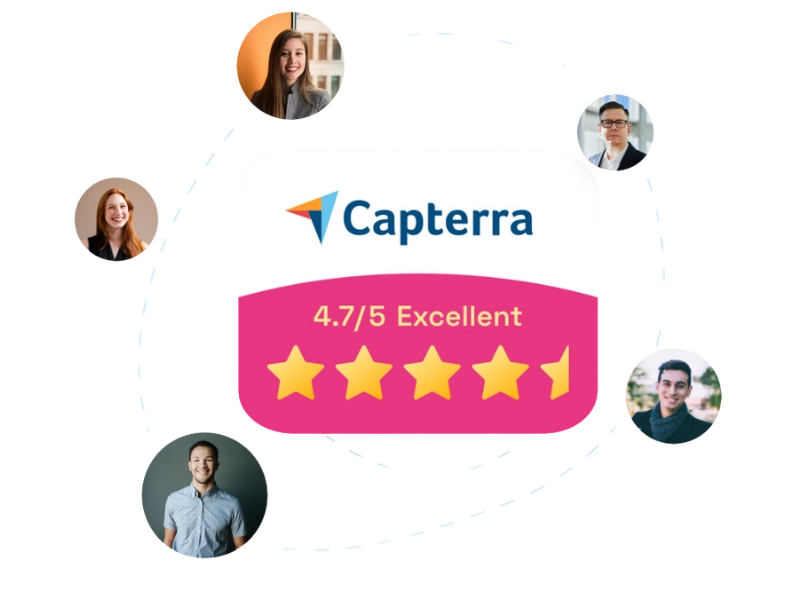Why Is Employee Engagement Important?
Employee engagement is one of the most profitable strategies for any company, as it affects employee motivation, productivity, and retention.
Creating an environment where workers are engaged means strengthening their sense of belonging to the company community, as well as their willingness to actively contribute to its growth.
In this article, we’ll explore the benefits of greater employee involvement and the recommended solutions from our experts to help you implement your initiatives.
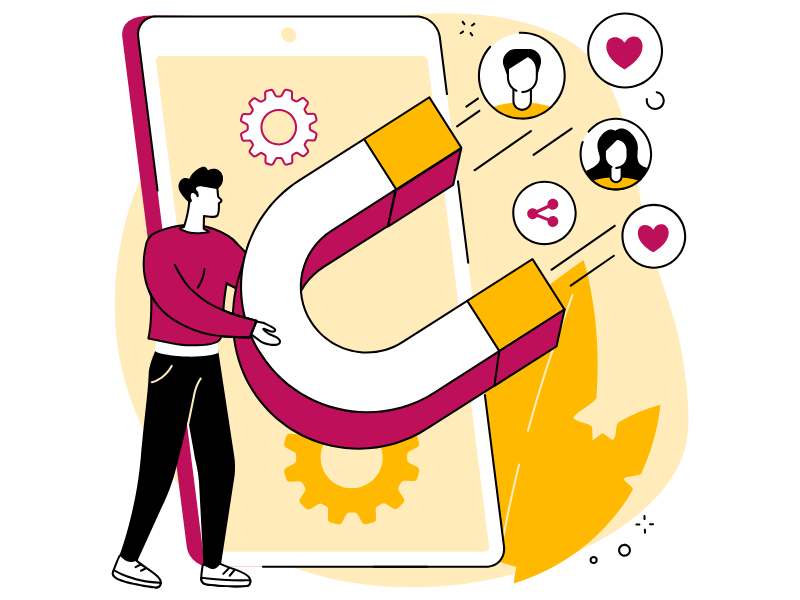
What you will find in this article
Introduction to the concept of employee engagement
Employee engagement is a concept that refers to the emotional involvement a worker develops towards their company.
In the past, the idea of an "employee" was almost exclusively tied to the concept of performance: what mattered were the tasks performed, adherence to schedules, and the achievement of goals set unilaterally by management.
Recently, however, companies have come to recognize that their ability to remain competitive in the long term primarily depends on their capacity to foster a climate of mutual trust with their people.
Thus, starting in the 1990s, a new term began to spread, namely "employee engagement," which reflects a new managerial philosophy focused more on the human factor as a core resource in an organization’s growth strategies.
This philosophy goes beyond simply observing job satisfaction; it encompasses all relational aspects that influence productivity, work quality, innovation capabilities, and talent retention.
Talents who increasingly seek meaning in their work, who aspire to a fulfilling career, and who want to be part of a work environment that respects their individual needs.
The concept of engagement urges us to view workers as partners to be valued for their ideas and commitment, and not merely as executors of directives.
This shift in perspective is deeply influencing how many companies operate, leading them to introduce:
- more transparent communication processes;
- policies aimed at recognizing each worker’s contribution;
- new opportunities for training and professional development.
With the advent of modern digital workplace technologies, the pursuit of authentic engagement has intensified, since there are now tools (such as the corporate intranet) that help build stronger relationships between companies and people, regardless of location, schedule, or type of work.

But is employee engagement really a valid strategy?
Numerous studies, including those by Gallup and SHRM, have shown that a high level of employee engagement has a direct impact on productivity, customer satisfaction, and a reduction in HR management costs.
From a practical standpoint, engaged personnel tend to show greater commitment in carrying out their tasks, actively participating in process improvement and feeling co-responsible for achieving company goals.
This translates into consistency, because the feeling of "having a purpose" increases determination and focus, while reducing absenteeism, burnout, and even turnover.
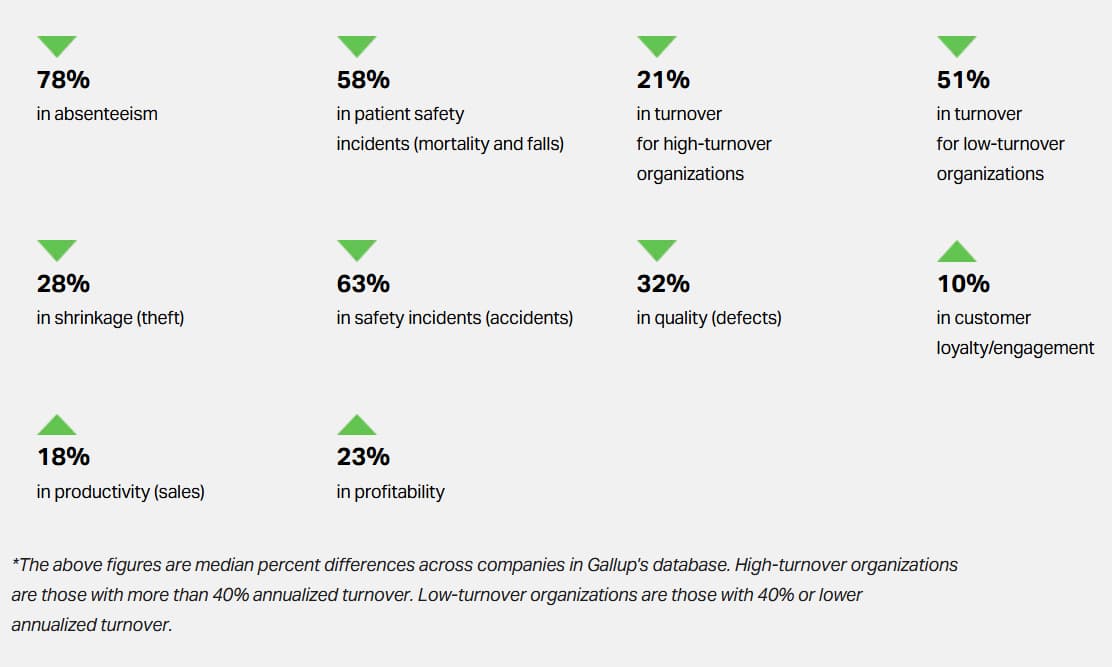
Impact of employee engagement initiatives as measured by Gallup
This creates a multiplier effect: the company becomes a place where people want to stay and grow, ensuring vital stability for business continuity.
In fact, one of the key insights in recent years is the direct connection between employee engagement and so-called "employee retention." Research shows that when a worker is engaged in what’s happening within the company, they are more likely to stay longer, as they are able to identify with the values and mission of the organization.
From an economic perspective, this phenomenon results in a reduction in costs, especially those related to turnover.
Every time a resource leaves the organization, investments must be made in recruiting, onboarding, and training. All of this adds to the loss of skills and relationships that each departing colleague inevitably takes with them.
It’s therefore clear that a solid engagement strategy positively impacts a company’s medium- and long-term stability and profitability. A cohesive workforce strengthens the ability to face change and makes the integration of new team members less traumatic, offering them a more open and collaborative environment.
To begin defining your engagement strategy, attention must be paid to four factors that influence employee involvement:
- Autonomy: When people have room to manage their activities, they develop a sense of responsibility and control, which positively affects motivation. A worker who can decide how to organize their day feels respected as a professional and perceives that the company values their skills.
- Recognition: Publicly appreciating contributions and providing constructive feedback are often underestimated actions that, on the contrary, encourage continuous improvement.
- Shared company culture: The set of values, norms, and behaviors that define a company creates fertile ground for cultivating a sense of belonging. When employees embrace the vision and identify with their organization’s values, a virtuous cycle is created that further strengthens the company community.
- Clear, realistic, and challenging goals: The absence of direction or unclear tasks and expectations leads to frustration. It’s essential to set ambitious yet achievable goals that energize the desire to get involved.
Together, these factors help create a workplace where each individual has the opportunity to feel not like just another cog in a distant machine, but a proactive contributor whose input is both sought and recognized as essential.

To conclude our introduction, we want to emphasize that to understand what employee engagement is, you also need to know what employee experience is, so as not to confuse these two seemingly identical concepts.
While employee engagement refers to the degree to which a colleague feels emotionally involved in company life, employee experience concerns the entire journey the worker takes within the company, from recruitment to possible exit.
Employee experience includes every phase and interaction, from the first interview to onboarding, from training programs to performance evaluation processes, and how the worker is supported during transitions or personal crises.
If this series of steps is managed consistently, it can foster the development of strong engagement.
In other words, one could say that employee engagement is, in part, the result of how the employee experience is managed.
A worker will be more inclined to feel connected to the company if:
- assigned goals have been handled transparently;
- they’ve had positive interactions with managers and colleagues;
- the company has recognized and valued their skills from the very beginning.
It is therefore important that HR managers and leadership members work together to define a strategy that aims to improve both dimensions simultaneously: on one hand, by enhancing the quality of the experience employees live every day at work; and on the other, by nurturing that sense of belonging that is essential to encourage people to stay and continue giving their best.
Why is employee engagement important?
One might think that an "engaged" employee is an abstract and hard-to-measure concept. In reality, there are specific metrics and KPIs that can demonstrate the tangible benefits of employee engagement.
These benefits are strongly evident in three main areas: productivity, turnover reduction, and organizational well-being.
Let’s take a closer look at each of them below.
Employee engagement and productivity
An environment where staff feel heard and valued encourages proactivity, collaboration, and creativity. People tend to stay consistently committed, offer ideas to improve internal processes, and respond more flexibly to daily challenges.
This effect of "discretionary extra effort," as highlighted by several studies, is highly valuable for companies because it helps them successfully navigate even the most difficult times.

Microsoft best practices to foster creativity in the workplace
Employee engagement and talent retention
Companies that do not invest in relationships with their employees are bound to face high costs related to replacing and training new resources. In contrast, companies that adopt employee engagement strategies see a significant reduction in the likelihood of voluntary resignations.
This is because, as we’ve already mentioned, highly engaged individuals tend to feel more connected to the organization’s mission and values, developing a sense of belonging that encourages them to stay longer.
As a result, employee engagement ensures better retention of internal know-how, while also reducing the burden of recruiting, onboarding, and "breaking in" new staff.
Employee engagement and well-being
Engagement impacts the overall quality of the work environment and the atmosphere among colleagues. When active listening and participation are encouraged, communication becomes smoother and tensions decrease, facilitating collaboration even across different departments.
Essentially, this creates conditions favorable to mutual respect and trust, paving the way for open dialogue between leadership and company teams. In turn, this results in fewer absences due to stress or relational discomfort.
Why, then, invest in employee engagement?
Taken as a whole, the factors listed above outline a scenario in which employee engagement becomes a new metric for assessing a company’s strength, resilience, and, consequently, its ability to remain competitive over time.
Recommended solutions to invest in employee engagement
Companies aiming to improve employee engagement (along with employee experience) cannot overlook the importance of adopting the right tools to build their digital workplace, tools designed to facilitate both collaboration and knowledge sharing.
The corporate intranet is one of the best platforms to achieve this goal, as it serves as the modern digital space where people, information, and resources are connected.
Thanks to the use of SharePoint Online and the other applications that make up the Microsoft 365 ecosystem, the intranet becomes the beating heart of the digital workplace, offering specialized features for the digitalization of all internal processes and the engagement of all workers.
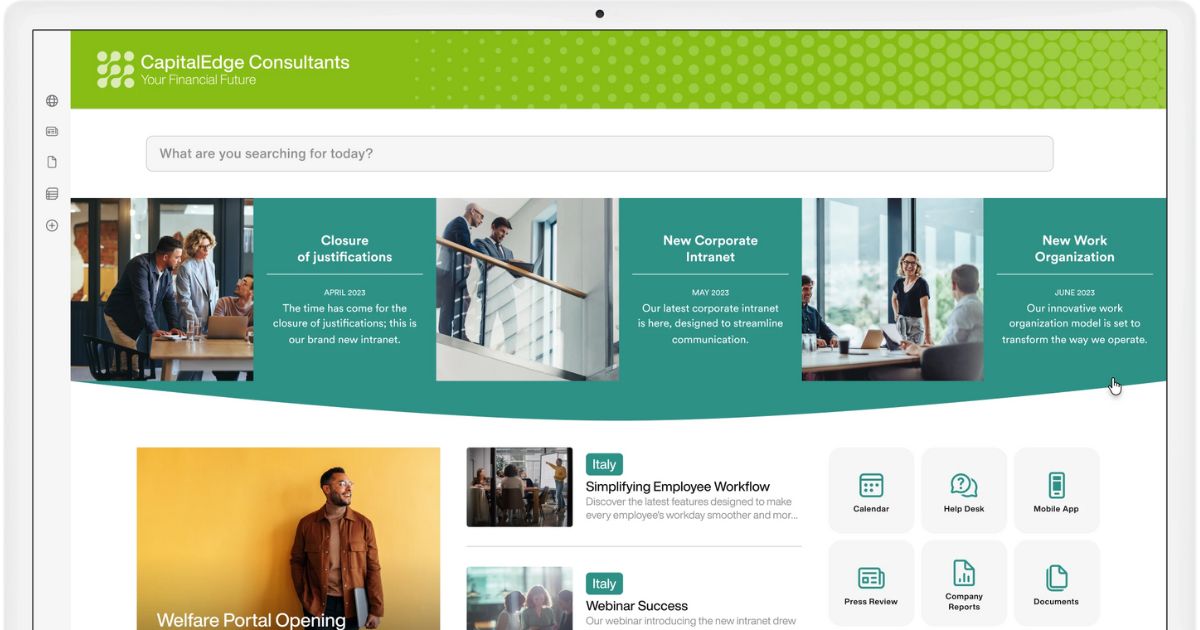
Example of a customized SharePoint intranet created with intranet.ai
Traditional intranets were limited to delivering news or updates from management, but the latest solutions (like the one offered by intranet.ai) aim to create a digital ecosystem where every employee can express themselves, feel heard, and contribute to the growth of their organization.
The focus is not top-down communication (although the intranet also serves this purpose), but rather facilitating peer-to-peer interactions and continuous knowledge sharing.
From this perspective, SharePoint is a valuable ally.
Together with the rest of the Microsoft applications (Teams, Viva Engage, Outlook, etc.), it enables:
- Centralization: All content, from internal communications to operational manuals, is made accessible in a single portal, avoiding dispersion across network folders or external platforms.
- Connection: Colleagues can work together in real time, co-create documents, carry out projects, and discuss new initiatives without barriers, whether technical or geographical.
- Engagement: The intranet provides features to support engagement initiatives (contests, surveys, thematic blogs, etc.) and make processes like onboarding and training more engaging, encouraging active employee participation.
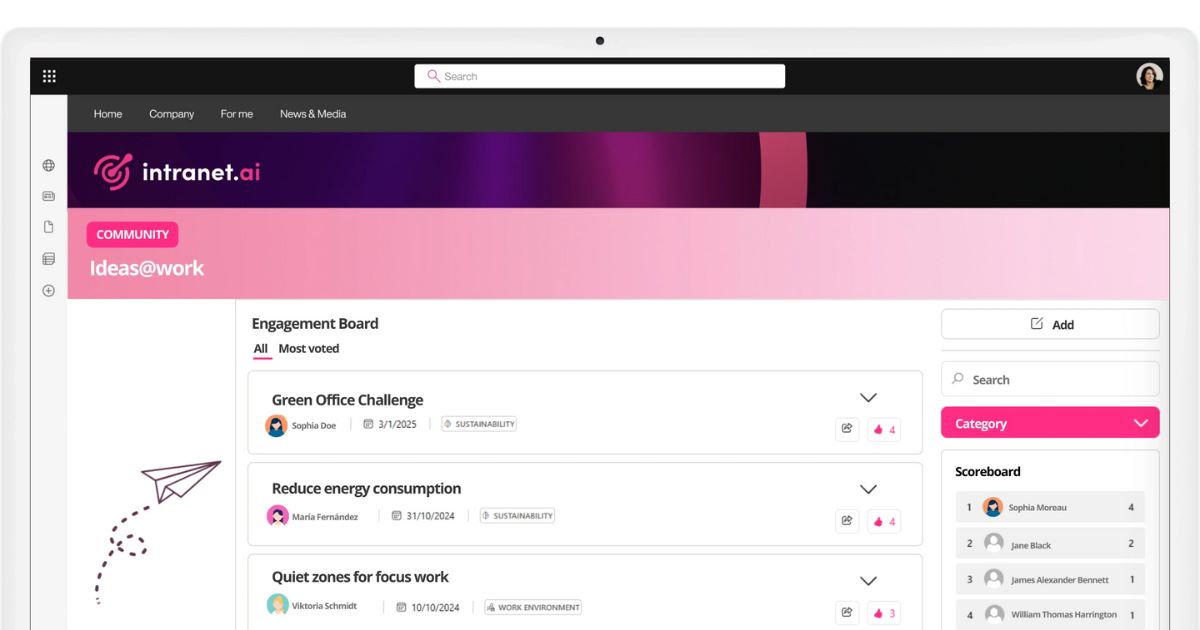
Engagement Board available in the SharePoint intranet by intranet.ai
In addition to the default features, the SharePoint Online intranet benefits from native integration with the Microsoft 365 ecosystem, enabling companies to create spaces for dialogue, recognition, and growth.
Among the main tools that can be integrated into the intranet to strengthen the sense of belonging to the company community, one of the most notable is Viva Engage.
Viva Engage is, in fact, the application specifically dedicated to engagement (as its name suggests). Within it, people in an organization can ask questions, share experiences, and participate in topic-based discussions.
This makes interaction more informal and immediate, even with management and company leaders.

Overview of Viva Engage, the corporate social network
To understand how important engagement is within a company (and how to improve it) we can ask ourselves a simple question: Why should users access the intranet?
If the answer is just "to download documents," engagement will suffer.
That’s why many organizations implement a "killer app," a feature so useful or appealing that it significantly boosts daily visits to the portal.
Accessing the intranet can become essential for daily tasks, such as viewing pay slips, managing leave requests, or submitting support tickets.
But the killer app can also help users discover new content: initiatives, training courses, recognition programs, contests, and much more, all with the goal of creating a virtuous cycle between intranet adoption and active user participation in company life.
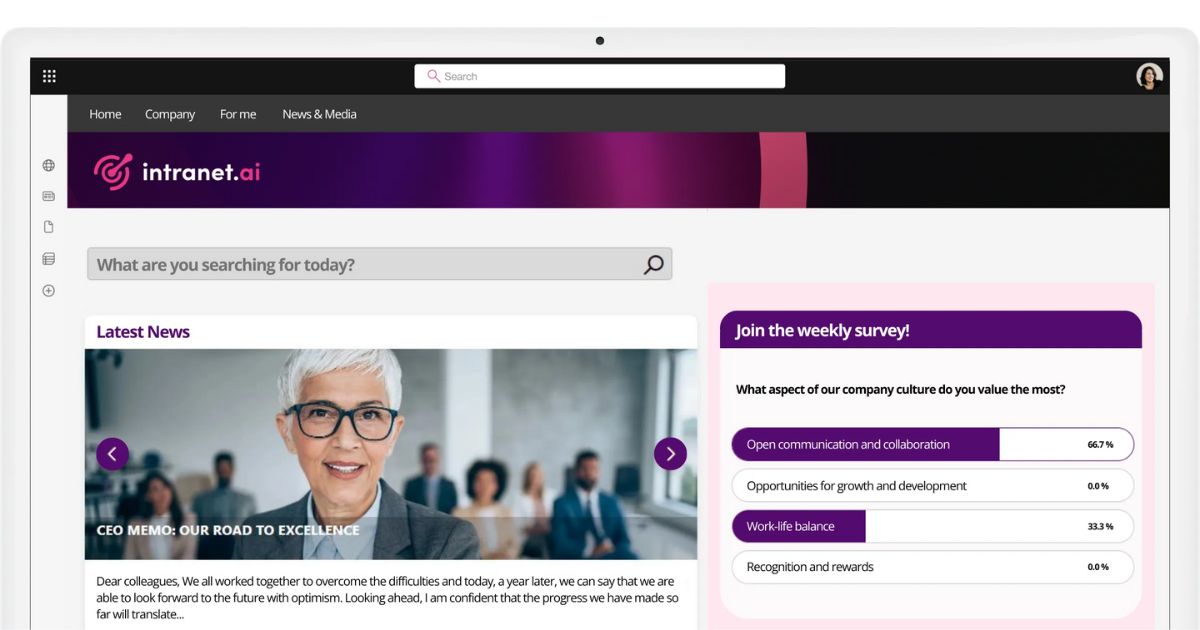
Quick polls in the SharePoint intranet by intranet.ai
Another aspect not to be overlooked is, of course, communication: news is important, but engagement is born from stories.
A company that gives voice to its people through dedicated intranet spaces (such as blogs, forums, and newsletters) shows that it values their experiences and the contributions they can offer to their colleagues.
For example, a blog written by members of a department can help share advice on how to tackle specific challenges or achieve certain goals.
Regardless of the context, first-person stories that are openly shared represent an invaluable resource to enrich corporate culture and inspire colleagues to give their best.
In short, information should not be one-way but participatory: when intranet users read and write content, they should see themselves in the collective narrative.
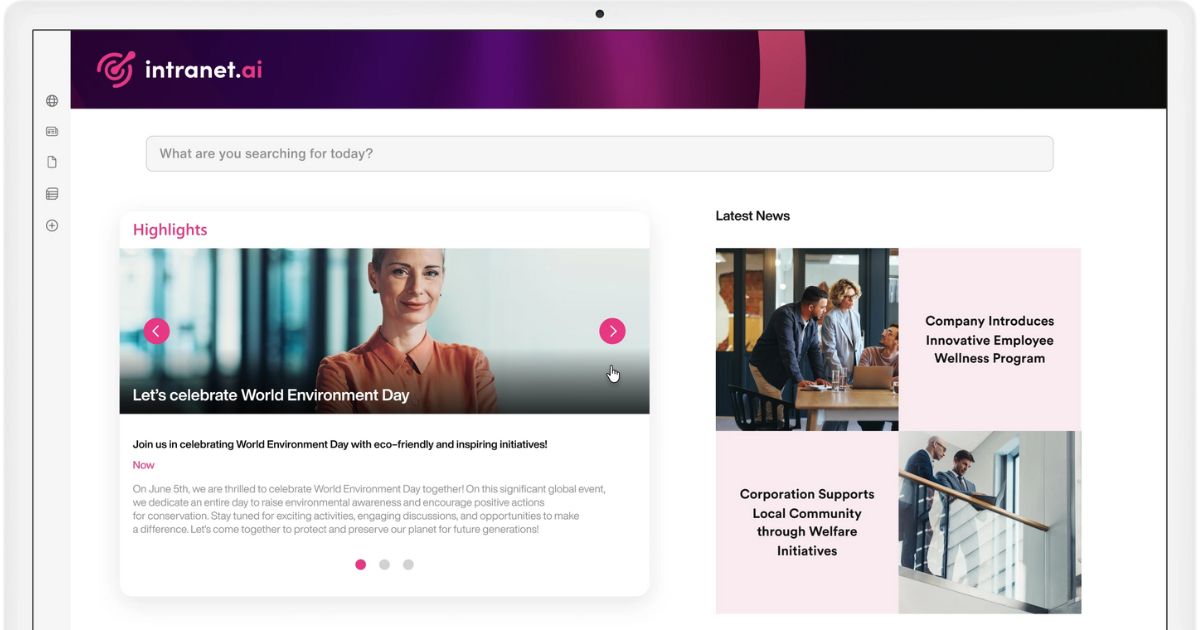
Highlighted communications in the SharePoint intranet by intranet.ai
Engagement also involves growth opportunities, as offering training sends a very clear message: "We believe in you, so we invest in your growth."
With Microsoft 365, training is no longer a top-down obligation but becomes a personalized and accessible experience. Let’s look at three tools from the suite:
- Viva Learning integrates e-learning resources directly into Teams, allowing employees to access courses whenever they prefer.
- SharePoint becomes the central hub for collecting training materials, video lessons, and structured learning paths.
- Microsoft Forms helps create quizzes and tests to assess skill development, making training more interactive.
Thanks to tools like these, it’s possible to implement a strategy of upskilling (helping colleagues deepen the skills they already possess) and reskilling (supporting people in acquiring new skills), improving workforce readiness and, above all, increasing their perceived value and personal fulfillment.
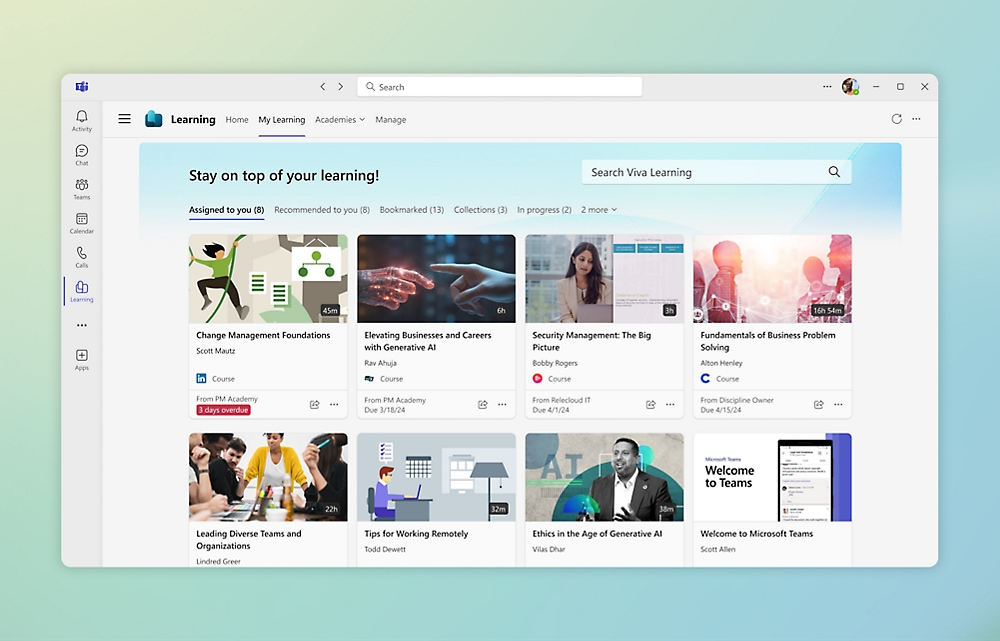
Overview of Viva Learning
The emotional component should never be underestimated.
Demotivation, lack of recognition, slow processes, and coordination difficulties are all causes of stress and disengagement, the very opposite of what a company should foster.
That’s why a structured management of information and collaboration can help contain inefficiencies while also enhancing employee engagement.
With SharePoint, Microsoft Teams, and Power Automate (just to name a few) we can create a centralized work environment where people collaborate in real time, share key information, and automate low-value tasks, significantly reducing the overall workload.
This way, every employee can focus on their objectives instead of wasting time on unproductive tasks. As a result, both individual and overall company productivity benefit.
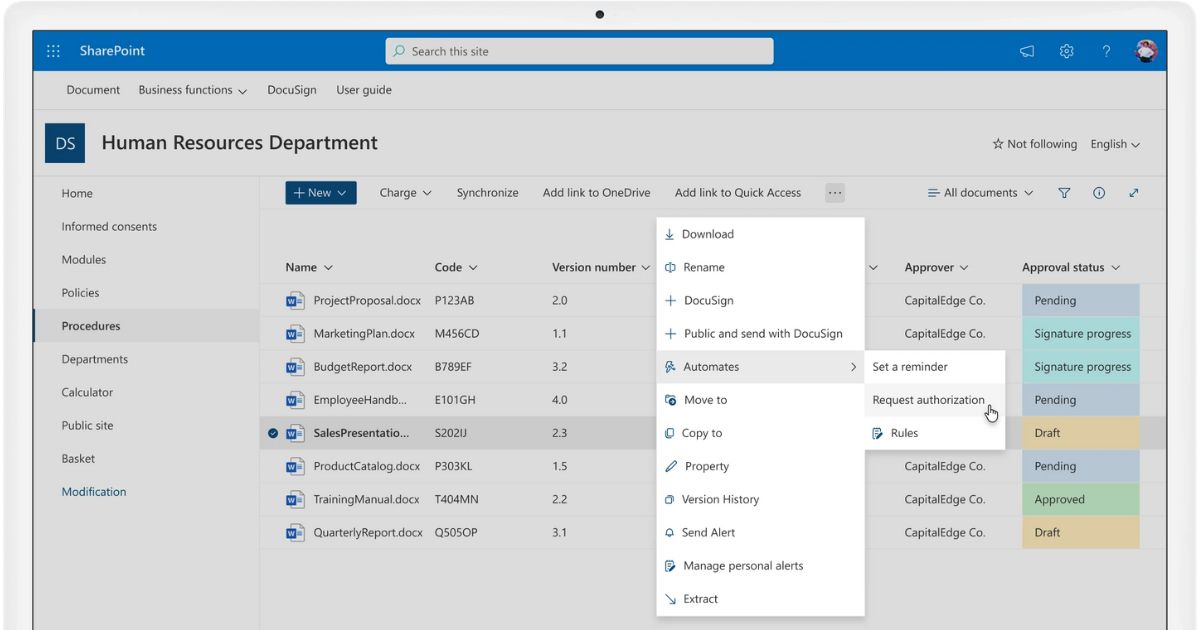
Simplifying document management in the SharePoint intranet by intranet.ai
One particularly effective way to increase engagement is through gamification, which can be created and managed directly within the intranet.
Thanks to integration with Microsoft 365 tools and the presence of blogs and discussion spaces, companies can launch initiatives like the ones listed in the table below.
| Gamification initiatives | Description |
| Hackathons or idea contests | Users, organized into teams, compete to find innovative solutions to real problems. Ideas are uploaded to the intranet, voted on by colleagues, and, if selected, receive concrete support for the experimentation phase. This method not only uncovers creative proposals but also encourages cross-departmental collaboration among teams that usually interact little. |
| Reward challenges | To encourage staff to complete training courses or e-learning modules, the company can assign badges or other recognitions visible on the intranet profile. Those who collect a certain number of badges can be rewarded with additional benefits or special mentions. A playful aspect that fosters friendly competition and leverages the desire for growth and professional recognition. |
| Themed communities | The use of Viva Engage or integration with Microsoft Teams channels, when properly promoted, helps create spontaneous communities where people discuss shared interests (a new tool, a niche topic, a volunteer project). This form of socialization fosters a sense of belonging and community, which is crucial for reducing isolation, especially in companies that adopt hybrid or distributed work models. |
At the end of this brief overview, we’ve seen how implementing a company intranet based on SharePoint Online and Microsoft 365 can bring tangible benefits in terms of employee engagement.
The clarity of communication, the ease of finding information, and the presence of dedicated spaces for learning and self-expression are unique advantages of the intranet that help strengthen the bond between company and employees.
When the intranet reflects the values of the organization and enables them to be expressed through concrete initiatives (contests, social projects, etc.), it builds a shared identity, in which colleagues and teams don’t just perform their tasks but understand their importance and feel responsible for them.
This is why employee engagement is and will remain a key strategy for any company; one to be nurtured over time, also through the use of solutions like the intranet and cutting-edge technologies from the Microsoft ecosystem.
Do you want a complete, ready-to-use intranet?
intranet.ai is the SharePoint Online-based solution for simplifying internal communication and digitizing business processes with minimal investment of time and money.
- 50+ features for communication and employee experience
- Branded design, customizable in every detail
- Full integration with Microsoft 365 and Viva
Giuseppe Marchi
Microsoft MVP for SharePoint and Microsoft 365 since 2010.
Giuseppe is the founder of intranet.ai and one of the top experts in Italy for all things Microsoft 365. For years, he has been helping companies build their digital workspace on Microsoft's cloud, curating the people experience.
He organizes monthly online events to update customers on what's new in Microsoft 365 and help them get the most out of their digital workplace.

FAQ on why employee engagement matters
What is employee engagement?
Employee engagement is the emotional and professional involvement that a worker develops toward the company. It goes beyond personal satisfaction and includes the willingness to actively contribute to the organization’s success and growth.
Why is employee engagement important for companies?
Because it directly impacts productivity, employee loyalty, and overall organizational well-being. Engaged employees work with greater motivation, feel part of a community, and tend to stay longer in the company.
What tangible benefits does a good engagement strategy bring?
An effective strategy leads to improved productivity, reduced turnover, and a more positive workplace atmosphere. It also helps preserve know-how and build a more stable work environment.
Are there data supporting the effectiveness of employee engagement?
Yes, studies conducted by Gallup and SHRM show that high engagement levels improve customer satisfaction, increase productivity, and lower operational costs related to personnel management.
What influences an employee’s level of engagement?
It depends on factors such as autonomy at work, recognition of achievements, shared company values, and clear goals. When these elements are present, engagement grows naturally.
What’s the difference between employee engagement and employee experience?
Employee engagement measures emotional involvement with the company. Employee experience, on the other hand, includes the entire journey a worker goes through, from recruitment to exit. A good experience fosters stronger and more lasting engagement.
How can the company intranet improve employee engagement?
With tools like SharePoint and Microsoft 365, the intranet provides spaces for communication, training, collaboration, and storytelling. This fosters a sense of belonging and encourages active participation in company life.
What practical initiatives can be promoted through the intranet?
The intranet can host contests, hackathons, thematic blogs, training paths, surveys, and interest-based communities. These activities strengthen company culture and build connections between colleagues across departments.
Is technology enough to generate engagement?
No, an organizational culture focused on listening, valuing people, and recognition is also needed. Technology is an enabler, but engagement is also built through authentic relationships and responsible leadership.
Why invest in employee engagement today?
Because it is an indicator of a company’s health and resilience. A cohesive and motivated team is better prepared to face challenges, adapt to change, and contribute to the company’s long-term competitiveness.
Keep on reading
The Best Strategies for Intranet Adoption



Tips, best practices, and solutions to successfully manage the launch and adoption of the intranet in your company, engaging all colleagues.
Microsoft Viva: How To Improve the Employee Experience

Let’s take a look at what Microsoft Viva is and how its applications improve communication, training, and information management in the company.
Employee Onboarding Process: Our Checklist to Implement It

What is the employee onboarding process? Why is it essential? Here are the key steps and examples to implement it and gain the maximum benefits.
